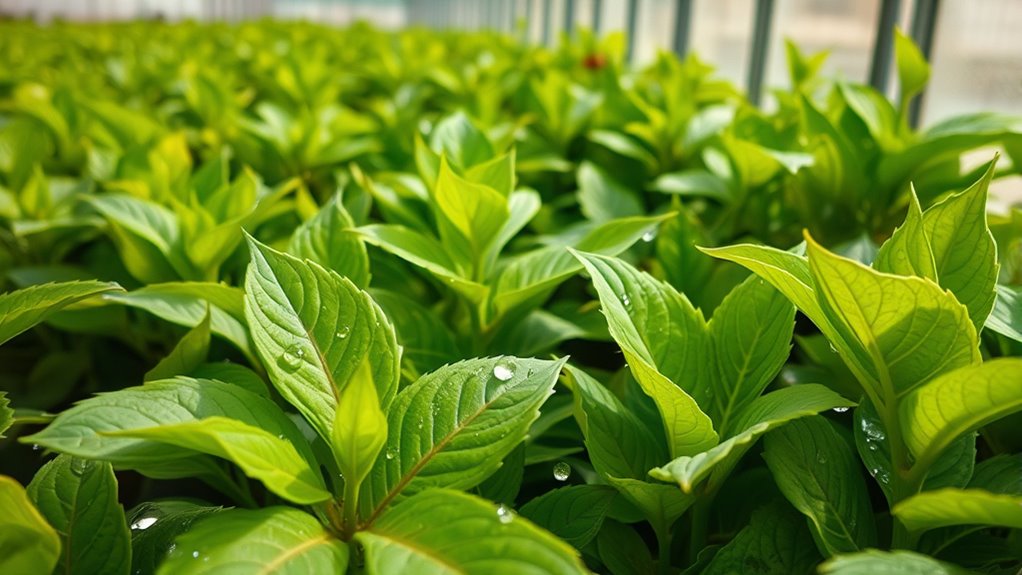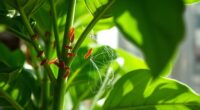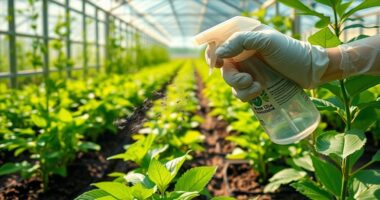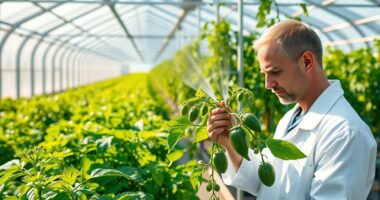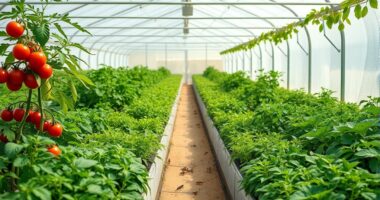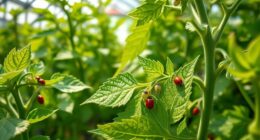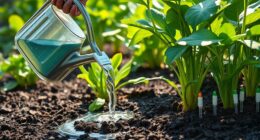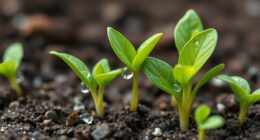To spot plant diseases early in your greenhouse, you should monitor environmental conditions and biological markers with sensor technology. These sensors track humidity, temperature, and internal plant changes, alerting you to potential issues before visible symptoms appear. Automated systems analyze data continuously, helping you catch problems quickly and take targeted actions. Staying ahead in disease detection boosts plant health, minimizes crop losses, and reduces manual inspections—keep exploring to uncover more effective strategies.
Key Takeaways
- Implement sensor systems to monitor environmental conditions and biological markers for early disease signals.
- Use real-time data analysis to detect subtle changes indicating pathogen presence before visible symptoms.
- Deploy automated alerts when biological markers or environmental anomalies suggest disease onset.
- Integrate biological sensors to identify specific molecules emitted by stressed or infected plants promptly.
- Regularly analyze sensor data to enable rapid intervention, reducing disease spread and crop damage.
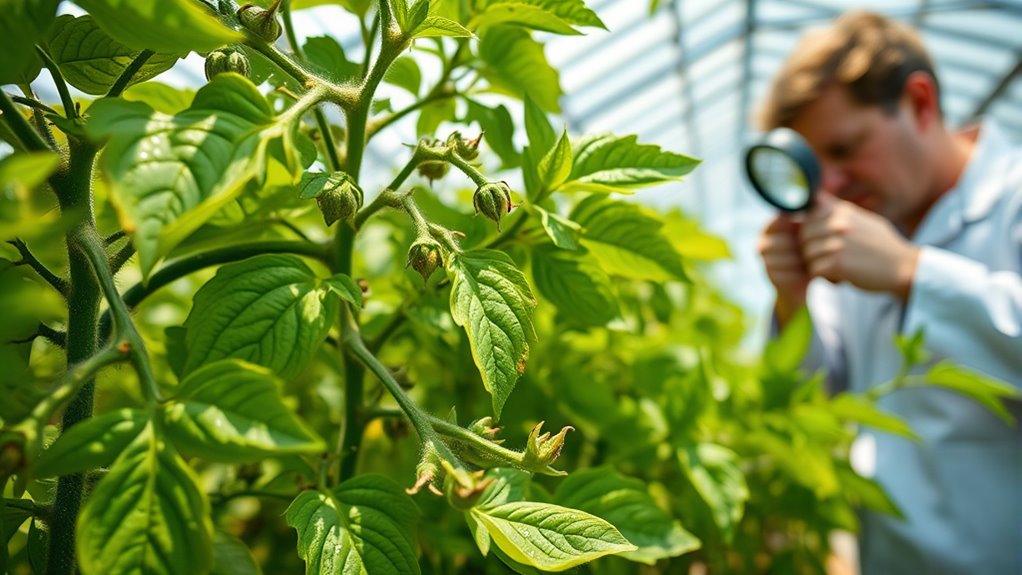
Have you ever wondered how farmers catch plant diseases before they cause widespread damage? The answer lies in innovative methods that leverage sensor technology and biological markers. In a greenhouse setting, early detection is essential to prevent the rapid spread of infections, and modern technology makes this possible with remarkable accuracy. Sensors can constantly monitor environmental conditions like humidity, temperature, and light, but they also serve a critical role in detecting subtle changes within plants themselves. These changes often occur before visible symptoms appear, giving you a head start in managing potential threats. By integrating sensor technology with data analysis, you can identify patterns and anomalies that signal the onset of disease, allowing for swift intervention.
Biological markers are a key component of this early detection process. These markers are specific molecules or compounds produced by plants or pathogens during the initial stages of infection. For example, certain enzymes or signaling proteins emitted by a plant under stress can indicate the presence of a disease well before you notice any visible signs. By deploying sensors capable of detecting these biological markers, you gain a powerful tool that alerts you to problems in real time. This approach minimizes the need for labor-intensive visual inspections and reduces the chance of overlooking early symptoms. Instead, you get precise, objective data that helps you make informed decisions quickly.
The combination of sensor technology and biological markers can be integrated into an automated system that continuously scans your greenhouse environment. These sensors can be connected to a centralized platform that analyzes incoming data and flags potential issues. For instance, if a sensor detects elevated levels of a specific biological marker associated with a pathogen, it sends an immediate alert to your device. This proactive approach means you can take targeted actions—such as adjusting humidity, applying treatments, or isolating affected plants—before the disease spreads further. It’s like having a health monitor for your crops, catching problems early enough to save your entire crop from damage.
Implementing these technologies might seem complex at first, but many systems are designed to be user-friendly and scalable. As you become familiar with how sensor data correlates with plant health, you’ll develop a sharper intuition for disease prevention. Ultimately, early detection powered by sensor technology and biological markers empowers you to maintain healthier plants, reduce chemical use, and improve yields. It’s a smarter, more efficient way to care for your greenhouse crops—giving you peace of mind knowing you’re staying one step ahead of potential plant diseases. Notably, tuning methods from automotive technology emphasize customized solutions that optimize performance, similar to how tailored detection systems enhance plant health management.
Frequently Asked Questions
What Are the Most Common Plant Diseases in Greenhouses?
In greenhouses, you often face common plant diseases like powdery mildew, botrytis, and downy mildew. To manage these, focus on pathogen identification early to prevent outbreaks. Implement disease management strategies such as proper ventilation, sanitation, and resistant varieties. Regularly inspect your plants for symptoms, and act quickly to control spread. Staying vigilant and informed helps protect your crops and maintain a healthy, productive greenhouse environment.
How Can Environmental Factors Influence Disease Development?
Imagine a greenhouse where humidity control slips, creating a damp environment. You might notice fungal diseases like powdery mildew spreading quickly. Environmental factors such as high humidity and poor temperature management directly influence disease development by promoting pathogen growth. By maintaining ideal humidity levels and temperature management, you can reduce disease risk, keeping your plants healthy and preventing outbreaks before they start.
Are There Specific Tools for Early Disease Detection?
You can use sensor technology and visual inspection tools for early disease detection. Sensors monitor environmental changes like humidity, temperature, and nutrient levels, alerting you to potential issues. Visual inspection involves regularly examining plants for symptoms such as spots, discoloration, or wilting. Combining these methods helps you identify diseases early, so you can take prompt action and prevent the spread, ensuring healthier plants and better yields in your greenhouse.
How Often Should I Inspect Plants for Signs of Disease?
A stitch in time saves nine, so you should inspect your plants regularly. For effective plant health monitoring, check your plants at least twice a week, paying close attention to leaves, stems, and soil. Frequent inspections help you catch signs of disease early, making pest identification and treatment easier. Consistent monitoring keeps your greenhouse healthy and productive, ensuring you catch issues before they spread.
What Are the Best Practices for Preventing Disease Spread?
To prevent disease spread, you should implement strict sanitation protocols, such as disinfecting tools and removing debris regularly. Use disease-resistant varieties whenever possible, as they’re less likely to develop issues. Keep a close eye on humidity and temperature levels to create an environment less favorable for pathogens. By combining these practices, you considerably reduce the risk of disease transmission and maintain healthier plants in your greenhouse.
Conclusion
So, congratulations—you’ve mastered the art of spotting plant diseases early. Now, instead of watching your lush green empire turn into a fungal horror show, you get to play the hero. Who knew that a keen eye and a little vigilance could save your crops from doom? Just remember, the real challenge isn’t catching the disease—it’s resisting the urge to become a plant detective in your own greenhouse. Happy gardening, Sherlock!
